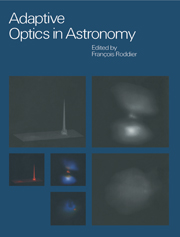Book contents
- Frontmatter
- Contents
- List of contributors
- Part one Introductory background
- Part two The design of an adaptive optics system
- Part three Adaptive optics with natural guide stars
- 8 The COME-ON/ADONIS systems
- 9 The UH–CFHT systems
- 10 Adaptive optics in solar astronomy
- Part four Adaptive optics with laser beacons
- Part five The impact of adaptive optics in astronomy
- Glossary of acronyms
- Index
10 - Adaptive optics in solar astronomy
from Part three - Adaptive optics with natural guide stars
Published online by Cambridge University Press: 23 November 2009
- Frontmatter
- Contents
- List of contributors
- Part one Introductory background
- Part two The design of an adaptive optics system
- Part three Adaptive optics with natural guide stars
- 8 The COME-ON/ADONIS systems
- 9 The UH–CFHT systems
- 10 Adaptive optics in solar astronomy
- Part four Adaptive optics with laser beacons
- Part five The impact of adaptive optics in astronomy
- Glossary of acronyms
- Index
Summary
Introduction
Much of the early experimentation on astronomical adaptive optics was done in the 1970s on the Vacuum Tower Telescope (VTT) at Sacramento Peak (Buffington et al. 1977; Hardy 1981, 1987) either on stellar objects or on the sun itself. That telescope, although only 76 cm in aperture, was ideally suited for such experimentation because of its attractive environment for instrumentation. Diffraction limited imaging at visible wavelengths on both stars and the sun was achieved by Hardy. The solar results then clearly demonstrated the limitations on adaptive-optics-aided solar research resulting from the small isoplanatic patch size (a few arcseconds). Since then a few other efforts have been mounted to achieve diffraction limited imaging in solar observations.
Solar adaptive optics systems differ in a number of significant aspects from systems developed for night-time astronomy. Specifically:
(i) since the sun is an extended object, wave-front sensing on point-like objects as is done mostly in night-time adaptive optics systems is not an option.
(ii) solar seeing is generally worse than night-time seeing because the zenith angle/air mass at which the sun is being viewed is large in the early morning when night-time seeing still prevails and because seeing caused by ground heating by sunlight becomes severe later in the day when the sun is seen at greater elevations.
(iii) solar telescopes have generally much smaller apertures than night-time telescopes none, except for the 150-cm aperture McMath–Pierce facility on Kitt Peak, exceeding 1 meter in diameter.
[…]
- Type
- Chapter
- Information
- Adaptive Optics in Astronomy , pp. 235 - 252Publisher: Cambridge University PressPrint publication year: 1999
- 1
- Cited by

